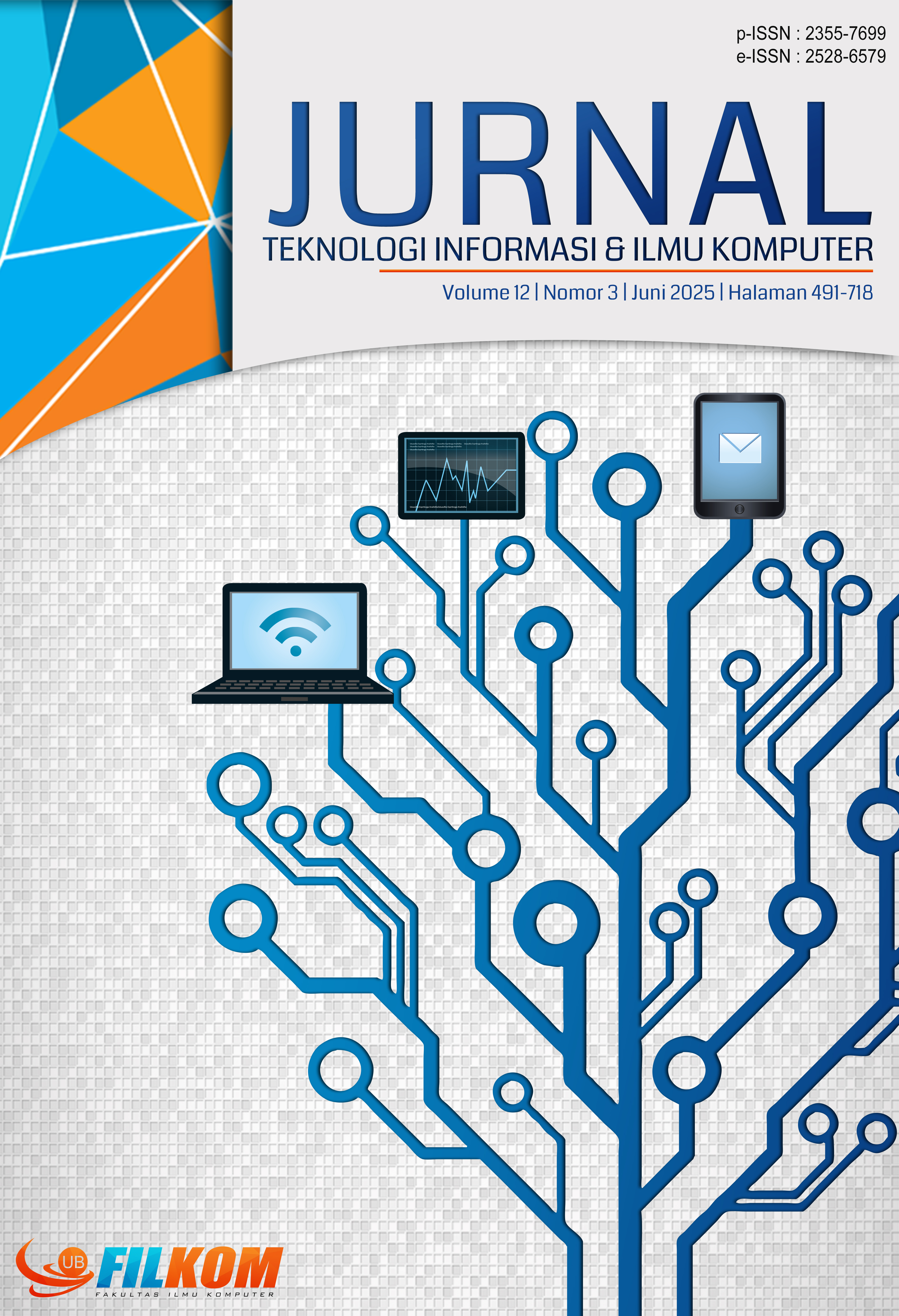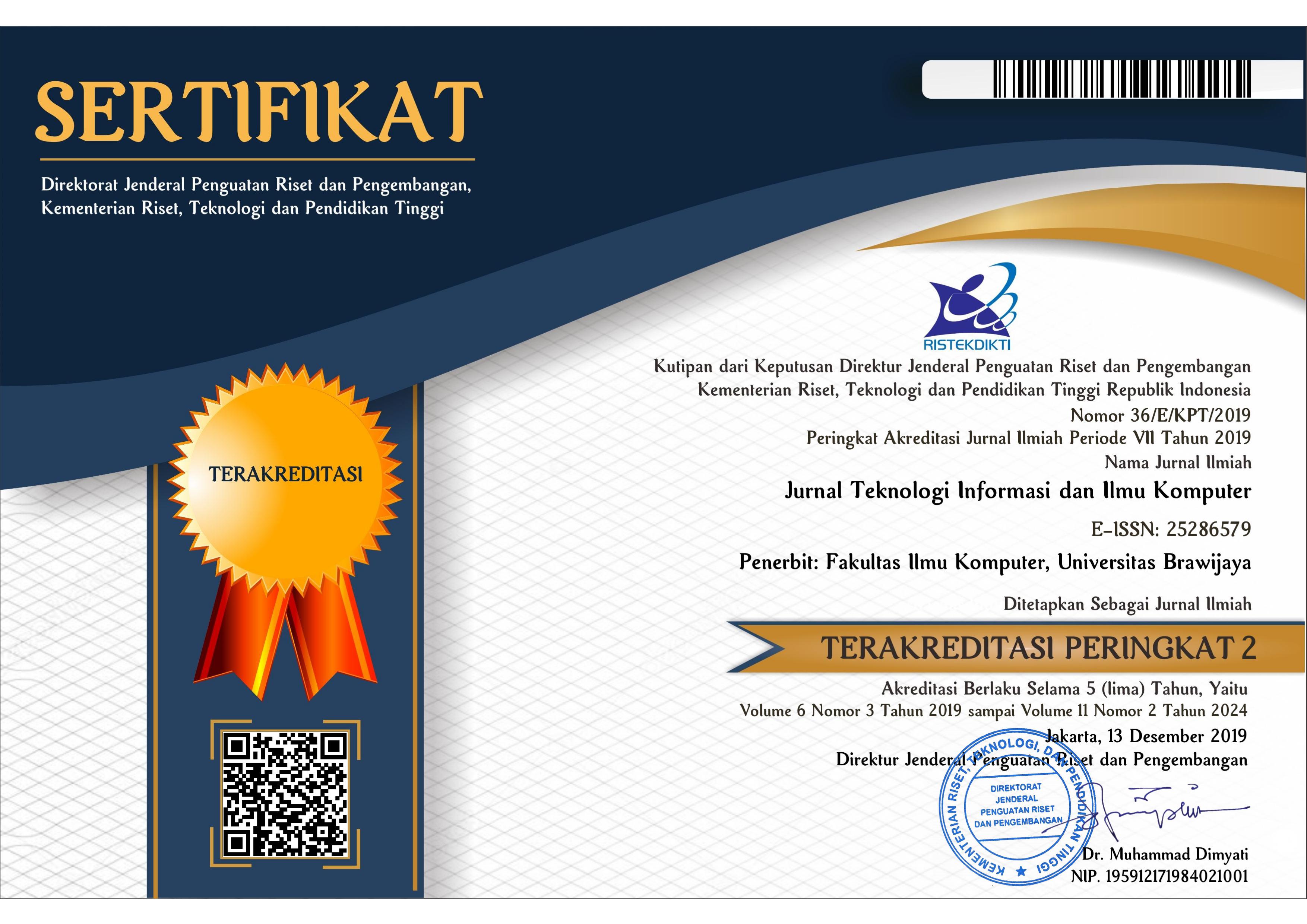Analisis Model Jalur Longitudinal Berbasis Glmm Pada Kasus Pasien Penderita Tuberkulosis Paru: Studi Simulasi
DOI:
https://doi.org/10.25126/jtiik.2025128415Kata Kunci:
analisis jalur longitudinal, GLMM, simulasi, struktur kovarian, tuberkulosis paruAbstrak
Evaluasi dan monitoring pada pasien penderita tuberkulosis paru membutuhkan pengobatan yang tepat. Dalam beberapa tahun terakhir, pada tahap monitoring telah ditemukan penanda biologis yang disebut suPAR (soluble urokinase plasminogen activator receptor) berpotensi sebagai biomarker untuk mendiagnosis, prognosis, dan evaluasi penyakit paru. Penelitian ini bertujuan untuk menyelidiki faktor-faktor yang berhubungan dengan pasien tuberkulosis paru dan menentukan faktor yang paling signifikan berdasarkan waktu pengamatan, indeks massa tubuh, dan laju endapan darah. Sampel sebanyak 60 pasien tuberkulosis paru di Malang dievaluasi secara longitudinal setiap dua minggu sekali selama 13 periode. Dalam penelitian ini, kami menggunakan analisis jalur dengan generalized linear mixed model (GLMM) dengan metode Weighted Least Square (WLS) untuk menyelidiki hubungan antarvariabel terhadap kadar monosit dan kadar suPAR pada pasien tuberkulosis paru. dan membandingkan hasilnya dengan Ordinary Least Square (OLS). Hasil penelitian menunjukkan bahwa model terbaik adalah GLMM dengan struktur kovarian unstructured dengan AIC terkecil dan R2 terbesar. Selain itu, indeks massa tubuh memiliki pengaruh yang paling signifikan terhadap kadar monosit dan suPAR pada pasien TB paru. Oleh karena itu, sangat penting untuk mempertimbangkan indeks massa tubuh pasien dalam evaluasi dan monitoring pasien tuberkulosis paru.
Abstract
Evaluating and monitoring patients with pulmonary tuberculosis needs an appropriate treatment. In recent years, a biological marker called suPAR (soluble urokinase plasminogen activator receptor) has been identified in the monitoring stage and has the potential as a biomarker for diagnosing, prognosing, and monitoring disease. This study aims to investigate the factors associated with patients with pulmonary tuberculosis and determine the most significant factor based on observation time, BMI, and ESR. A total of 60 patients diagnosed with pulmonary tuberculosis in Malang were included and evaluated longitudinally every two weeks over 13 periods. In this study, we use path analysis with the generalized linear mixed model (GLMM) using the Weighted Least Square (WLS) method to investigate the relationship between the variables on monocyte and suPAR levels in pulmonary tuberculosis patients and compare the results those obtained using the Ordinary Least Square (OLS) method. The results demonstrate that the optimal model is the GLMM with an unstructured covariance structure, exhibiting the smallest AIC and the largest R2. Additionally, body mass index exerts the most significant effect on monocyte and suPAR levels in patients with pulmonary tuberculosis. Consequently, considering patient’s BMI when evaluating and monitoring patients with pulmonary tuberculosis is imperative.
Downloads
Referensi
AHMED, N. N. & ABDULLAH, S. N., 2024. Cluster Analysis on Logitudinal Data of Patients with Kidney Dialysis Using a Smoothing Cubic B-Spline Model. International Journal of Mathematics, Statistics, and Computer Science, Volume 2, pp. 85-95.
CASCARANO, A. ET AL., 2023. Machine and deep learning for longitudinal biomedical data: a review of methods and applications. artificial intelligence review, Issue https://doi.org/10.1007/s10462-023-10561-w, pp. 1-61.
CHOI, H. ET AL., 2021. Body Mass Index, Diabetes, and Risk of Tuberculosis: A Retrospective Cohort Study. Frontiers in Nutrition, pp. 1-11.
ENOCSSON, H., LUKIC, T., ZIEGELASCH, M. & KASTBOM, A., 2021. Serum Levels of The Soluble Urokinase Plasminogen Activator Receptor (suPAR) Correlates with Disease Activity in Early Rheumatoid Arthritis and Reflect Joint Damage Over Time. Translational Research, pp. 142-149.
FERNANDES, A. A. R. ET AL., 2019. Smoothing Spline Nonparametric Path: Application for The Green Product and Green Marketing Strategy towards Green Product Purchasing Intention. s.l., s.n.
HU, J. & SZYMCZAK, S., 2023. A review on longitudinal data analysis with random forest. Briefings in Bioinformatics, 24(2), pp. 1-11.
HUSSAIN, Y. A., MOHAMMED, K. & ALI, N., 2023. Potential Immunological Biomarker for Diagnosis and Prognosis of Tuberculosis. European Journal of Biomedical Research, 2(1), pp. 17-22.
KIPLIMO, R. ET AL., 2021. Longitudinal-Survival Models for Case-Based Tuberculosis Progression. Frontiers in Public Health, 9(543750), pp. 1-10.
KUSNIR, P., DOHAL, M., PORVAZNIK, I. & MOKRY, J., 2020. Serum Inflammation Markers in Tuberculosis. Acta Medica Martiniana, 20(3), pp. 103-113.
LEVALETT, L., ORTEGA, H. & BARRERA, L. F., 2020. Infection of Monocyte From Tuberculosis Patients With Two Virulent Clinical Isolated of Mycobacterium Tuberculosis Induces Alterations in Myeloid Effector Functions. Frontiers in Cellular and Infection Microbiology, pp. 1-17.
MANGAONGKAR, A. A., TANDE, A. J. & BEKELE, D. I., 2021. Differential Diagnosis and Workup of Monocytosis: A Systematic Approach to A Common Hematologic Finding. CUrrent Hematologic Malignancy Reports, 16(3), pp. 267-275.
MUKAKA, M. M., 2012. Statistics Corner: A Guide to Appropriate Use of Correlation Coefficient in Medical Research. Malawi Medical Journal, 24(3), pp. 69-71.
RAHMANDA, L. R. ET AL., 2024. Performance of Neural Network in Predicting Mental Health Status of Patients with Pulmonary Tuberculosis: A Longitudinal Study. Media Statistika, 16(2), pp. 124-135.
RSSA, 2022. Data Pasien Tuberkulosis Paru. Malang: Rumah Sakit Saiful Anwar.
TAYE, M. A., 2020. Sedimentation Rate of Erythrocyte from Physics Prospective. The European Physical Journal E, 43(3), pp. 1-7.
TISHKOWSKI, K. & GUPTA, V., 2023. Erithrocyte Sedimentation Rate. [Onine] ed. s.l.:StatPearls Publishing.
VERBEKKE, G. & MOLENBERGHS, G., 2000. Linear Mixed Model for Longitudinal Data. New York: Springer Verlag.
WARDANI, Y. & DARNIUS, O., 2022. Path Analysis Model in Determining The Crime Rate During Covid 19 Pandemic in North Sumatera. Journal of Mathematics Technology and Education, 1(2), pp. 209-221.
WHO, 2022. Global Tuberculosis Report 2022, Geneva: World Health Organization.
WU, L. & QIU, J., 2021. Applied Multivariate Statistical Analysis and Related Topics with R. France: Science Press.
Unduhan
Diterbitkan
Terbitan
Bagian
Lisensi
Hak Cipta (c) 2025 Jurnal Teknologi Informasi dan Ilmu Komputer

Artikel ini berlisensiCreative Commons Attribution-ShareAlike 4.0 International License.

Artikel ini berlisensi Creative Common Attribution-ShareAlike 4.0 International (CC BY-SA 4.0)
Penulis yang menerbitkan di jurnal ini menyetujui ketentuan berikut:
- Penulis menyimpan hak cipta dan memberikan jurnal hak penerbitan pertama naskah secara simultan dengan lisensi di bawah Creative Common Attribution-ShareAlike 4.0 International (CC BY-SA 4.0) yang mengizinkan orang lain untuk berbagi pekerjaan dengan sebuah pernyataan kepenulisan pekerjaan dan penerbitan awal di jurnal ini.
- Penulis bisa memasukkan ke dalam penyusunan kontraktual tambahan terpisah untuk distribusi non ekslusif versi kaya terbitan jurnal (contoh: mempostingnya ke repositori institusional atau menerbitkannya dalam sebuah buku), dengan pengakuan penerbitan awalnya di jurnal ini.
- Penulis diizinkan dan didorong untuk mem-posting karya mereka online (contoh: di repositori institusional atau di website mereka) sebelum dan selama proses penyerahan, karena dapat mengarahkan ke pertukaran produktif, seperti halnya sitiran yang lebih awal dan lebih hebat dari karya yang diterbitkan. (Lihat Efek Akses Terbuka).















